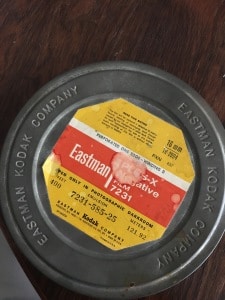By Carol Lyon
Recently, Doorstep Digital worked with a client family in the Houston area near the Galleria who are big photography fans. Not only do they own a large collection of old vintage photos and albums, but they also have home videos made from 16mm and 8mm film. We scanned their photos and negatives and also transferred their film to an easy to view digital format. During a discussion with this family, it became evident that they really know their history about film: they informed us that the film type that preceded 16mm was actually highly flammable and gave rise to a common fear of both theater fires and panic-driven stampedes caused by them. This eventually lead to a widely accepted belief that it is illegal to shout “fire!” in a public theater. We found these little-known facts about the history of film to be very intriguing. Is there truly a law against shouting “fire!” in a theater? What makes the film so dangerous? Do people still have this kind of film, and how is it distinguished from other types? We ventured into a quest for answers. The result was a fascinating education in history, chemistry, political science, and American idioms.
In 1923, Kodak released the Cine-Kodak Camera, which used 16mm film much like the film owned by our Houston client family. 16mm film became the standard for home videos and amatuer filmmakers because it was much more user-friendly than its predecessor 35mm film, which remained the standard film type in major theaters until the 1950’s. Not only was 35mm a complicated medium for both shooting and projecting movies, it was also considered extremely dangerous for its flammable tendencies. 35mm and most types of photographic prints before the invention of Kodak’s 16mm film were made from nitrocellulose, or nitrate film. To give you an idea of how flammable this material is, it was also called “guncotton” and “flash paper.” A fire caused by nitrate film would look something like this: a movie would be beautifully projecting on the big screen until suddenly the film gets jammed in the gate of the projector. The high temperature of the lamp inside would ignite the film. Once the film catches fire, it is very difficult to put it out because the chemical reaction creates its own oxygen to feed the flames. Even submerging the film in water will not quench it, as one projectionist in Seattle found out when he threw a flaming reel into a toilet. The toilet exploded! Needless to say, it was necessary for movie theaters to implement some safeguards. Projection booths were lined with metal walls, and metal shutters were rigged over the windows in such a way that if a fire started, they would close and the door would slam automatically. This would keep the fire contained inside the booth. Alterations were made to the projectors themselves so that fires would either be snuffed out at their onset or at least be contained within the projector’s casing. These precautions appear to have been effective since there have only been seventy-five recorded cases of theater fires worldwide between 1896 and 1993. The last known case occurred in 2009 in a theater in Palo Alto. The fire was completely contained in the projection booth, and ironically the water sprinklers caused more damage than the fire.
Nevertheless, it’s probably not a good idea to put film as flammable as gunpowder in the hands of amateurs. So, when kodak manufactured their new line of 16mm film for the general public, they made it from a safer plastic base called cellulose acetate, or “safety film.” Safety film is not exactly fireproof–it will melt and burn–but it does not spontaneously combust like its uncle nitrate can supposedly do in certain conditions. By the way, nitrate film becomes even more flammable as it ages. When stored in a warm environment overtime, it decomposes into powder that becomes an extreme fire hazard. In fact, more fires took place in warehouses storing moldering nitrate film than in movie theaters, which is why not many original nitrate films have survived for modern public view. Acetate film decomposes as well, but the worst that will happen is that the images will fade and the film will smell like vinegar. In case any of you are getting nervous, there are two ways to tell if you have nitrate film. First, there should be a label reading “nitrate” on the edge of the film. If so, you either have an original nitrate film or an acetate copy of one. Second, you can tear off a small piece of the film and carefully light it with a match. According to one article, “If it burns briskly with a bright yellow flame, it’s nitrate. If it only melts and smokes, it’s ‘safety’ acetate film.”
Today, video is primarily captured digitally. 16mm safety film and it’s younger brother 8mm film have become a retro artform, and 35mm nitrate film is a rare collectible item seldom used or even talked about. The plausibility of a projection booth in a movie theater suddenly becoming a furnace on high heat is no longer a worry at the forefront of people’s minds. But before the 1950’s, it was a legitimate scenario, and fear has the propensity to turn an otherwise docile audience into a crazed mob. Thus, it is generally believed that there is a federal law specifically outlawing shouting “fire!” in a movie theater. But does any such law exist? The answer is no.
The mythical law has its origin in the Supreme Court Case Schenck v. United States of 1919, which had nothing to do with fires, theaters, or nitrate film. The court case was about a man named Charles Schenck who had printed flyers urging Americans to resist the draft of WWI. Schenck claimed that he was acting within his right to freedom of expression. The Supreme Court disagreed with Schenck and ruled against him. Justice Oliver Wendell Holmes Jr. was recorded as saying, “The most stringent protection of free speech would not protect a man in falsely shouting fire in a theatre and causing a panic” (italics added by author). Holmes was analogizing Schenck’s criticism of the draft to falsely shouting fire in a crowded theater in order to explain the court’s belief that Schenck was creating a “clear and present danger” to the American public. Of course, in 1919, the metaphor would have had more significance when nitrate film made theaters more susceptible to fires, but the idea caught on and outlived the advancements in cinema technology. “You can’t yell fire in a crowded theater” became the go-to idiom for putting down controversial claims to freedom of speech in the United States. Moreover, the phrase gave rise to a mythical law that supposedly prohibits literally shouting fire in a theater. Technically, yes, if someone shouts fire when there is no fire, they run the risk of being prosecuted for disorderly conduct that puts people in danger, which could happen at a theater or a ball game or an airport or a concert or anywhere with a crowd. However, if there really is a fire, there would most likely be no legal consequences.
And there ends our scenic quest through the history of film and its influence on American culture for today. It’s like the Smithsonian: the connections between interesting facts seem limitless! We look forward to more explorations into the history of film, photos, negatives, and slides catalyzed by our very knowledgeable clients.
Sources:
- http://www.talltalestruetales.com/2010/02/dennis-nyback-on-nitrate-film/
- http://www.dennisnybackfilms.com/2010/02/nitrate-film-more-feared-than-frankenstein-less-understood-than-eraser-head-more-dangerous-than-repeated-viewing-of-sleepless-in-seattle/
- http://www.archivesfilmworks.com/uploads/1/2/5/3/12531554/16mm_format_history_v2.pdf
- http://www.rsc.org/chemistryworld/2013/07/cellulose-acetate-film-rayon-podcast
- http://www.firstamendmentcenter.org/not-many-exceptions-to-free-speech-guarantee
- http://civil-liberties.yoexpert.com/civil-liberties-general/is-it-legal-to-shout-%22fire%22-in-a-crowded-theater-19421.html

